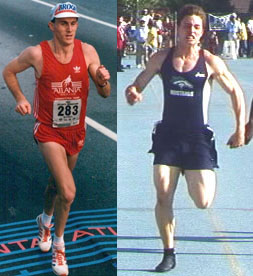Interval Training: Steady-State Cardio is Obsolete
First off, if you want to lose weight, I hope you've gotten your diet in order. I'm not talking a temporary yo-yo diet, I mean changing your eating habits for good.
Now, I'm sure you've noticed the "steady-staters" when you go in the gym. They're the ones that will be jogging on the treadmill for hours on end, usually at a steady pace. This really ISN'T an efficient way of losing fat at all!
When you push your body for a long period of time, for long distances, it will actually switch over to burning your muscle for energy. Now, steady-state does have its place (like if you compete in long distance events or are a bodybuilder, just don't go at high intensities for long distances if you're a bodybuilder) but for the average person trying to lose fat through cardiovascular exercise, it's obsolete.
Got Muscle?

Recommended Reading
Do You Want to Burn Fat or Muscle?
Don't believe me? Look at the marathon runner (on the left) and compare him to the sprinter (look at that face). Who looks like they actually have some muscle on them? Now who looks like a skeleton?
Your body is a lot smarter than you think. It knows that if you're going to run such long distances that it doesn't need all that extra muscle, and that bigger muscles are much more inefficient at exchanging oxygen from your capillaries to your cells (which is needed to create energy for aerobic exercise), because there is more space that the oxygen has to travel, from the capillaries to the cells. In that case, your bigger muscle fibers are just excess weight, that are inefficient at exchanging oxygen and are a great source of energy.
Plus, your endurance muscle fibers are some of the smallest muscle fibers on your body (which is good for the oxygen exchange). When you run long distances, those are the fibers you'll be working the most. Your fast twitch muscle fibers (or Type II fibers) are your bigger muscle fibers and they give out pretty quickly. You can only perform at such a high intensity for short bursts until your bigger muscle fibers tire out. When you do something like sprinting those are the fibers you target.
That's why a sprinter looks ripped and a marathon runner looks like a skeleton. They target different muscle fibers AND a marathon runner is often times running on empty... so muscle will get burnt as energy.
If overall weight loss is that important to you, and you don't care if you lose muscle along with fat, then by all means run long distances at a steady state. So how do you keep your healthy tissue, your muscle, and still lose fat? That's right, intervals.
What's An Interval?
So what's an interval? All you have to do is change either the pace, resistance or movement a few times during your workout.
Let's say you like to run for cardio and you start out with a decent pace to warm up. Once you've got a certain distance or a certain length of time, pick up your pace (sprint if you can). Go a set amount of time or distance at that pace and then slow down to a fast walk. You'll go back up and down, up and down in these intervals.
See how simple it is?
You just fluctuate back and forth and you'll work your body a lot harder. If you're on a treadmill you can change the speed and/or incline. That's why they have the pre-programmed settings like hill climbs and such but I prefer to control it myself using the manual setting.
Not only is it harder for you to run in intervals, but you will continue to burn extra calories throughout the day because you did intervals. Most people will watch the read out on the treadmill to see how many calories they burned and expect that number to make a huge difference. That's why they'll jog for hours on end.
But do you really have time for that? No, probably not.
And does it work? Not really.
With intervals, not only will you burn calories while you're doing them, but your metabolism will be boosted enough to burn extra calories throughout the rest of the day.
Don't Think Intervals Will Work You Hard Enough? Try This!
I forget which magazine I got this idea from, but I'm willing to bet that I can have you panting and wheezing in 12 minutes. And in this 12 minutes you'll work your body harder than if you did 30 minutes or more of steady-state cardio of the same kind.
Not only will you feel that you worked harder immedietly after you finished, you may also notice it when you step on the scale if you do this often enough.
Are you ready?
This is literally not for the weak-hearted, overly obese or if you have joint problems.
- I want you to jog for 4 minutes, this will be to get your body warmed up.
- Once you hit that 4 minute mark I want you to sprint for 10 seconds. 10 seconds, that's it, come on you can do that tough guy!
- As soon as the 10 seconds is up you can walk for 20 seconds.
- But don't get too cozy, when that 20 seconds is up, you're going to be sprinting for another 10 seconds.
- I want you to go back and forth like this for 4 minutes. So that's 8 sprinting intervals and 8 walking intervals.
- And once you're done with that you can do a 4 minute jog as a cooldown.
Now let me know how you feel after just one 12 minute cardio session. Do you feel like you worked yourself more than your normal steady-state cardio? I thought so.
If you have issues with getting the timing right, you can make a song and add it to your mp3 player. That way you just listen and you know when to jog, sprint or walk based on the song you're listening to.
- You pick a song that will get you warmed up and cut it off at the 4 minute mark (you'll need software like MP3Cutter on your computer)
- And then you want to pick a song that's more hardcore, something you could sprint to. (You'll want to make sure these are cut in a way that the music starts as soon as it switches to the next song) Cut the hardcore song off 10 seconds into it. (Make sure that you're saving each of these mini-songs you're making)
- Now pick a song that's softer, something that'd be nice to walk to. Cut this song off 20 seconds in.
- What you can do with MP3Cutter is put cut marks on the first song every 10 seconds and then, when you split them into separate files, just keep the first 8 sections. Do the same for the slower song, but in 20 second sections.
- Now pick a song that's upbeat but nice and drawn out, something you can imagine yourself relaxing to. You can keep this the full length if you want.
You can keep this the full length because, when I would run, I'd do it outside and the first two parts (the warm up and the intervals) I'd be running one way and the cooldown I'd just turn around and run back. If you do it this way, the cooldown will be a little longer.
Ok, now piece the song together. Put your 4 min warm up first, then your first hardcore piece and then your first softer piece. Alternate back and forth with them till you've put all 8 of each in place and then at the end put your cooldown song. And you can now link all of this together as one song.
Now load it on your mp3 player and you're ready to go! All you have to do now is listen. You hit play, start your run and pay attention, your song will tell you when to change pace. I usually hit play and then quickly start the timer on my watch, so I can keep track of my progress.
Recommended Reading
More Ways to Train in Intervals
Now if that wasn't enough, you can actually do intervals with bodyweight exercises, weights and machines! You won't really be changing the speed, but you'll be doing different movements at different weights.
You just pick a few exercises you want to do, and do them all straight through back to back with no rest, pretty fast paced, then you can rest for a minute or two and start the circuit over again. With this type of workout, not only will you lose fat, you'll also be gaining muscle.
I've done both types of workouts. I did the 12 minute cardio one for 4 months, two times a week. (I also was lifting weights 4 times a week) I dropped 12 lbs, now this might seem like nothing but I also had gained huge amount of muscle, so it's hard to just go by overall weight.
Now the bodyweight intervals I did only for 2 months, but I'd do this 5 times a week. It consisted of pushups, boxing, plyometrics and such. In those 2 months I lost 18 lbs.
So you can see how well intervals work.
I hope you've learned something from reading this and I hope that you'll at least try to use intervals in some way. If you take my 12 minute challege, please let me know how it went in a comment below. I'd be happy to hear about any progress in your fat loss journey too.







